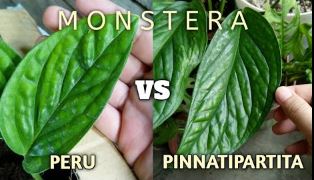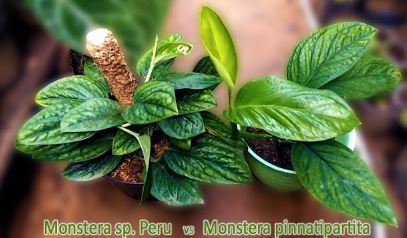Monstera Pinnatipartita and Monstera Peru stand as captivating members of the Monstera family, each boasting unique traits that make them favorites among plant enthusiasts. In this detailed exploration, we will delve into their characteristics, growth patterns, and the intriguing world of Monstera varieties.
Introduction
Monstera Pinnatipartita, native to diverse habitats, exhibits a remarkable blend of aesthetic appeal and resilient growth. Thriving in various environments, from tropical rainforests to indoor gardens, this species is distinguished by its climbing nature and captivating leaf structures.
Monstera Peru, on the other hand, hails from the lush rainforests of Peru and showcases distinctively textured foliage, setting it apart in the realm of Monstera varieties. Its climbing habits and iridescent leaves contribute to its allure among plant enthusiasts.
Signifying their significance in horticulture, both Pinnatipartita and Peru have become sought-after additions to indoor and outdoor gardens. As we embark on this journey, we will unravel the complexities that differentiate and connect these two fascinating plants.
Is Monstera Siam the Same as Monstera Peru?
Are Monstera Siam and Monstera Peru truly identical, or do their paths diverge as they mature? Initially similar in their juvenile stages, Monstera Siam and Peru eventually reveal distinct leaves as they grow. While both can endure low light conditions, providing medium to bright indirect light accelerates their growth, allowing their unique features to shine.
Monstera Siam, often misunderstood as Peru during its early days, transforms into a plant with leaves that markedly differ from its Peruvian counterpart. This metamorphosis emphasizes the importance of considering maturity stages when identifying and caring for these captivating species.
In online plant communities, enthusiasts frequently share experiences of cultivating both Siam and Peru. These discussions reveal valuable insights into the care practices that contribute to their optimal growth. Providing a platform for individuals to showcase their thriving Siam and Peru plants, Reddit communities offer a wealth of information for those eager to learn and share their plant journeys.

Monstera Siam vs Peru vs Pinnatipartita: Unraveling the Trio
Comparing the growth habits and leaf structures of Monstera Siam, Peru, and Pinnatipartita unveils a fascinating trio of variations within the Monstera family. While all three share climbing tendencies and epiphytic characteristics, nuances in their leaf textures and shapes become apparent as they mature.
Monstera Siam’s oval-shaped leaves in its juvenile stage may lead to confusion with Peru, but their distinctive features become more evident with time. Pinnatipartita, with its larger and longer leaves, offers a unique contrast to the compressed appearance of Peru’s foliage. Exploring the growth patterns of these three species provides valuable insights into their individual preferences and requirements for thriving in diverse environments.
Online platforms, especially Reddit, serve as hubs for plant enthusiasts to share their experiences in distinguishing between Siam, Peru, and Pinnatipartita. These discussions often include tips on caring for each species, further enriching the collective knowledge of the plant-loving community.
Monstera Siam vs Peru Care

Ensuring the well-being of Monstera Siam and Peru involves understanding their specific care requirements. Both species can handle low light conditions, but a strategic approach to lighting contributes to accelerated growth and the development of larger, more distinctive leaves.
Light plays a pivotal role in the care of Monstera Siam, influencing its growth trajectory and leaf morphology. While it can tolerate low light, providing medium to bright indirect light encourages robust development. This insight into the relationship between light exposure and plant growth is essential for cultivating thriving Siam specimens.
Similarly, Monstera Peru exhibits a preference for bright light, distinguishing it from its counterparts. Tolerating higher light levels than Pinnatipartita, Peru thrives when exposed to ample brightness. The nuances in light preferences among these species underscore the importance of tailoring care practices to each plant’s unique characteristics.
To enhance the care of Monstera Siam and Peru, enthusiasts often turn to online resources, such as Planterina and Bokay Florist, where comprehensive guides offer valuable insights into the specific needs of these captivating plants.
Monstera Peru: Unveiling the Mysteries
Monstera Peru, also known as Monstera Karstenianum Peru or Monstera sp. Peru, captivates with its textured foliage and climbing vines. Unraveling the mysteries surrounding its name and origin reveals a plant with unique characteristics that set it apart in the world of Monstera varieties.
The nomenclature of Monstera Peru introduces an intriguing aspect of the plant’s identity. Commonly referred to as Monstera Karstenianum, this species lacks a universally accepted scientific name. However, it may share a botanical lineage with philodendrons native to Venezuela. The care guidelines for both Monstera Peru and Monstera karstenianum align, highlighting the importance of understanding the intricacies of plant taxonomy.
The allure of Monstera Peru extends beyond its name, encompassing the economics of plant cultivation. The rarity of this species, coupled with its distinctive features, contributes to its higher market value. Exploring the economic perspectives of why Monstera Peru is relatively expensive sheds light on the dynamics that shape the pricing of sought-after plant varieties.
In the realm of rarity and growth, the question arises: Is Monstera Peru truly a rare find? Delving into its growth speed and propagation methods reveals insights into the factors that contribute to the perception of rarity. The distinctiveness of Peru’s foliage, coupled with its climbing habits, adds to its appeal among plant collectors.
Exploring Monstera Pinnatipartita’s Unique Traits
Monstera Pinnatipartita, a plant of elegance and rare beauty, offers a captivating presence in both natural and indoor settings. Understanding its unique traits, growth preferences, and the distinguishing features that set it apart from other Monstera varieties enhances the appreciation for this exquisite species.
Pinnatipartita’s preference for bright light distinguishes it from Peru, as it can thrive in environments with more intense illumination. This unique trait contributes to the development of its distinctive large fenestrations, creating a visual spectacle that adds to its allure.
Comparing Monstera Pinnatipartita with Monstera Peru highlights the differences in their growth and aesthetics. Pinnatipartita’s leaves, larger and longer than those of Peru, create a visual impact that draws attention. The interplay between light conditions and the growth patterns of Pinnatipartita enriches the overall understanding of its unique characteristics.
Insights from platforms like Foliage Friend provide a glimpse into the experiences of plant enthusiasts who have cultivated Pinnatipartita. Frequently asked questions and answers contribute to a comprehensive guide for those looking to embrace the challenge of caring for this rare and elegant Monstera species.
The Mystique of Monstera Varieties: Additional Insights
Beyond the realm of Pinnatipartita and Peru, the Monstera family harbors additional varieties that enthrall collectors and enthusiasts alike. Delving into the allure of Monstera Siam, the fascination with variegated Monsteras, and the nuances between Pinnatipartita and Subpinnata provides a holistic understanding of the diversity within this captivating plant family.
Monstera Siam emerges as a rare gem, captivating plant enthusiasts with its distinctive qualities. Unraveling the mysteries surrounding its rarity and allure unveils a plant that stands out among the myriad of Monstera varieties. As collectors seek unique additions to their green spaces, Siam becomes a coveted choice, contributing to the dynamic landscape of rare houseplants.
The intricacies of variegated Monsteras add an additional layer of fascination to the world of plant collecting. Exploring the sought-after traits and cultivation challenges associated with variegation sheds light on the complexities that contribute to the allure of these visually stunning varieties. The vibrant patterns of variegated Monsteras create a visual feast that captivates plant enthusiasts.
Navigating the differences between Monstera Pinnatipartita and Subpinnata introduces plant enthusiasts to the subtle variations within the Monstera family. Comparative analysis of their leaf structures and unique traits provides insights into the nuances that distinguish these closely related species. Understanding these differences enhances the discernment of plant collectors and contributes to the rich tapestry of Monstera varieties.
Conclusion
In conclusion, the exploration of Monstera Pinnatipartita and Peru unveils a tapestry of intricacies within the Monstera family. From the distinctive features that set each species apart to the care practices that contribute to their optimal growth, these plants continue to capture the hearts of enthusiasts worldwide. As we navigate the complexities of Monstera cultivation, the allure of rare varieties like Siam and the mystique of variegation add depth to the ever-evolving world of plant collecting.
Addressing common queries and misconceptions ensures that enthusiasts embark on their Monstera journey armed with accurate information. From understanding the economic perspectives behind the pricing of Monstera Peru to unraveling the mysteries of nomenclature, this exploration has provided a comprehensive guide for both novice and seasoned plant lovers.
Looking ahead, the future trends and developments in Monstera cultivation promise exciting discoveries and the emergence of new varieties. Anticipating evolving trends within plant enthusiast communities and the potential discovery of unique Monstera species adds an element of excitement to the journey of nurturing these captivating foliage friends.
| Key Differences | Monstera Pinnatipartita | Monstera Peru |
|---|---|---|
| Root System Growth | Relatively faster growth of aerial roots | Slower growth, contributing to popularity |
| Leaf Structure | Large fenestrations on dark green leaves | Thick, bubbly, and glossy appearance |
| Growing Habits | Thrives in deep shade but can adapt indoors | Flourishes in bright light, avoiding direct sunlight |
| Temperature Tolerance | Ideal range: 65 to 80ºF | Ideal range: 65 to 80ºF |
| Ideal Humidity | At least 60% | Requires extreme humidity; yellow leaves indicate low humidity |
FAQ’s
1. Is Monstera Pinnatipartita Rare?
Answer: Yes, Monstera Pinnatipartita is considered a rare plant within the Monstera family. Its rarity adds to its allure, making it a coveted choice among plant enthusiasts.
2. What is the Key to Monstera Pinnatipartita Care?
Answer: The key to Monstera Pinnatipartita care lies in maintaining ideal humidity levels (at least 60%), providing a well-draining compost/pot mix, regular watering (a few times a day), and accommodating low light conditions.
3. Is Monstera Pinnatipartita Common?
Answer: No, Monstera Pinnatipartita is not a common Monstera species. Its rarity sets it apart from more widely available varieties like Adansonii, Peru, Dubia, and Deliciosa.
4. How Much Light Do Monstera Plants Need?
Answer: Monstera plants generally need five to eight hours of indirect light each day for optimal growth. Variegated varieties may require exposure to more light to enhance their vibrant coloring.
5. How to Clean a Monstera Plant at Home?
Answer: To keep Monstera plant leaves clean and healthy, wipe them with a damp cloth every week. Additionally, use a water jar for watering the top few inches of leaves daily.
6. What Type of Soil is Best for a Monstera Plant?
Answer: Monstera thrives best in dense, nutrient-rich soil. It is recommended to use a soil mix with a slightly acidic pH for optimal plant health.
7. What are the Watering Requirements for Monstera?
Answer: Water your Monstera once every two to three weeks to avoid root rot. Check the soil to determine if the plant needs water; if it’s dry, water the plant immediately.
8. Is Monstera Peru Actually a Rare Find?
Answer: Yes, Monstera Peru is considered a relatively rare find. Its unique foliage and climbing habits contribute to its perceived rarity among plant collectors.
9. What is the Difference Between Monstera Pinnatipartita and Subpinnata?
Answer: The differences between Monstera Pinnatipartita and Subpinnata lie in their leaf structures and unique traits. Comparative analysis reveals nuances that distinguish these closely related species.
10. Is Monstera Peru Variegated?
Answer: While Monstera Peru is not typically known for variegation, the glossy and bubbly appearance of its leaves, coupled with the play of light, may give the illusion of a variegated pattern.
